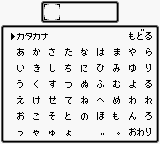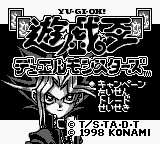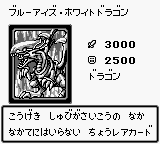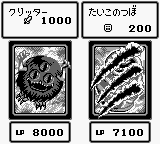Difference between revisions of "Yu-Gi-Oh! Duel Monsters (video game)"
(more details on the different ways of getting cards) |
(→Link Cable Fusion: removing repetition) |
||
| Line 289: | Line 289: | ||
===Link Cable Fusion=== | ===Link Cable Fusion=== | ||
| − | A Fusion can be performed using the Game Link Cable, while connecting to either a second copy of ''Yu-Gi-Oh! Duel Monsters'' or ''[[Yu-Gi-Oh! Dark Duel Stories|Yu-Gi-Oh! Duel Monsters III: Dark Duel Stories]]''. This requires the two Fusion Material Monsters, as well as "[[Change Slime (DM1)|Change Slime]]". | + | A Fusion can be performed using the Game Link Cable, while connecting to either a second copy of ''Yu-Gi-Oh! Duel Monsters'' or ''[[Yu-Gi-Oh! Dark Duel Stories|Yu-Gi-Oh! Duel Monsters III: Dark Duel Stories]]''. This requires the two Fusion Material Monsters, as well as #289 "[[Change Slime (DM1)|Change Slime]]". |
The player gets to keep the card permanently, if they conduct a Fusion using this method. | The player gets to keep the card permanently, if they conduct a Fusion using this method. | ||
| Line 298: | Line 298: | ||
! scope="col" colspan="2" | Material 1 | ! scope="col" colspan="2" | Material 1 | ||
! scope="col" colspan="2" | Material 2 | ! scope="col" colspan="2" | Material 2 | ||
| − | |||
|- | |- | ||
| 037 | | 037 | ||
| Line 306: | Line 305: | ||
| 039 | | 039 | ||
| [[Curse of Dragon (DM1)|Curse of Dragon]] | | [[Curse of Dragon (DM1)|Curse of Dragon]] | ||
| − | |||
| − | |||
|- | |- | ||
| 069 | | 069 | ||
| Line 315: | Line 312: | ||
| 016 | | 016 | ||
| [[Time Wizard (DM1)|Time Wizard]] | | [[Time Wizard (DM1)|Time Wizard]] | ||
| − | |||
| − | |||
|- | |- | ||
| 092 | | 092 | ||
| Line 324: | Line 319: | ||
| 091 | | 091 | ||
| [[Mystic Horseman (DM1)|Mystic Horseman]] | | [[Mystic Horseman (DM1)|Mystic Horseman]] | ||
| − | |||
| − | |||
|- | |- | ||
| − | | 056 | + | | rowspan="9" | 056 |
| − | | [[Larvae Moth (DM1)|Larvae Moth]] | + | | rowspan="9" | [[Larvae Moth (DM1)|Larvae Moth]] |
| − | | 123 | + | | 123 |
| [[Dark Plant (DM1)|Dark Plant]] | | [[Dark Plant (DM1)|Dark Plant]] | ||
| − | | 278 | + | | rowspan="9" | 278 |
| − | | [[Petit Moth (DM1)|Petit Moth | + | | rowspan="9" | [[Petit Moth (DM1)|Petit Moth]] |
| − | |||
| − | |||
|- | |- | ||
| − | |||
| − | |||
| 157 | | 157 | ||
| [[Firegrass (DM1)|Firegrass]] | | [[Firegrass (DM1)|Firegrass]] | ||
| − | |||
| − | |||
| − | |||
| − | |||
|- | |- | ||
| − | |||
| − | |||
| 274 | | 274 | ||
| [[Green Phantom King (DM1)|Green Phantom King]] | | [[Green Phantom King (DM1)|Green Phantom King]] | ||
| − | |||
| − | |||
| − | |||
| − | |||
|- | |- | ||
| − | |||
| − | |||
| 273 | | 273 | ||
| [[Ancient Tree of En (DM1)|Ancient Tree of En]] | | [[Ancient Tree of En (DM1)|Ancient Tree of En]] | ||
| − | |||
| − | |||
| − | |||
| − | |||
|- | |- | ||
| − | |||
| − | |||
| 008 | | 008 | ||
| [[Mushroom Man (DM1)|Mushroom Man]] | | [[Mushroom Man (DM1)|Mushroom Man]] | ||
| − | |||
| − | |||
| − | |||
| − | |||
|- | |- | ||
| − | |||
| − | |||
| 075 | | 075 | ||
| [[Man-eating Plant (DM1)|Man-eating Plant]] | | [[Man-eating Plant (DM1)|Man-eating Plant]] | ||
| − | |||
| − | |||
| − | |||
| − | |||
|- | |- | ||
| − | |||
| − | |||
| 158 | | 158 | ||
| [[Man Eater (DM1)|Man Eater]] | | [[Man Eater (DM1)|Man Eater]] | ||
| − | |||
| − | |||
| − | |||
| − | |||
|- | |- | ||
| − | |||
| − | |||
| 238 | | 238 | ||
| [[Yashinoki (DM1)|Yashinoki]] | | [[Yashinoki (DM1)|Yashinoki]] | ||
| − | |||
| − | |||
| − | |||
| − | |||
|- | |- | ||
| − | |||
| − | |||
| 180 | | 180 | ||
| [[Arlownay (DM1)|Arlownay]] | | [[Arlownay (DM1)|Arlownay]] | ||
| − | |||
| − | |||
| − | |||
| − | |||
|- | |- | ||
| − | | 072 | + | | rowspan="9" | 072 |
| − | | [[Cocoon of Evolutio (DM1)|Cocoon of Evolutio]] | + | | rowspan="9" | [[Cocoon of Evolutio (DM1)|Cocoon of Evolutio]] |
| 123 | | 123 | ||
| [[Dark Plant (DM1)|Dark Plant]] | | [[Dark Plant (DM1)|Dark Plant]] | ||
| − | | 056 | + | | rowspan="9" | 056 |
| − | | [[Larvae Moth (DM1)|Larvae Moth | + | | rowspan="9" | [[Larvae Moth (DM1)|Larvae Moth]] |
| − | |||
| − | |||
|- | |- | ||
| − | |||
| − | |||
| 157 | | 157 | ||
| [[Firegrass (DM1)|Firegrass]] | | [[Firegrass (DM1)|Firegrass]] | ||
| − | |||
| − | |||
| − | |||
| − | |||
|- | |- | ||
| − | |||
| − | |||
| 274 | | 274 | ||
| [[Green Phantom King (DM1)|Green Phantom King]] | | [[Green Phantom King (DM1)|Green Phantom King]] | ||
| − | |||
| − | |||
| − | |||
| − | |||
|- | |- | ||
| − | |||
| − | |||
| 273 | | 273 | ||
| [[Ancient Tree of En (DM1)|Ancient Tree of En]] | | [[Ancient Tree of En (DM1)|Ancient Tree of En]] | ||
| − | |||
| − | |||
| − | |||
| − | |||
|- | |- | ||
| − | |||
| − | |||
| 008 | | 008 | ||
| [[Mushroom Man (DM1)|Mushroom Man]] | | [[Mushroom Man (DM1)|Mushroom Man]] | ||
| − | |||
| − | |||
| − | |||
| − | |||
|- | |- | ||
| − | |||
| − | |||
| 075 | | 075 | ||
| [[Man-eating Plant (DM1)|Man-eating Plant]] | | [[Man-eating Plant (DM1)|Man-eating Plant]] | ||
| − | |||
| − | |||
| − | |||
| − | |||
|- | |- | ||
| − | |||
| − | |||
| 158 | | 158 | ||
| [[Man Eater (DM1)|Man Eater]] | | [[Man Eater (DM1)|Man Eater]] | ||
| − | |||
| − | |||
| − | |||
| − | |||
|- | |- | ||
| − | |||
| − | |||
| 238 | | 238 | ||
| [[Yashinoki (DM1)|Yashinoki]] | | [[Yashinoki (DM1)|Yashinoki]] | ||
| − | |||
| − | |||
| − | |||
| − | |||
|- | |- | ||
| − | |||
| − | |||
| 180 | | 180 | ||
| [[Arlownay (DM1)|Arlownay]] | | [[Arlownay (DM1)|Arlownay]] | ||
| − | |||
| − | |||
| − | |||
| − | |||
|- | |- | ||
| 057 | | 057 | ||
| Line 495: | Line 388: | ||
| 072 | | 072 | ||
| [[Cocoon of Evolutio (DM1)|Cocoon of Evolutio]] | | [[Cocoon of Evolutio (DM1)|Cocoon of Evolutio]] | ||
| − | |||
| − | |||
|- | |- | ||
| 067 | | 067 | ||
| Line 504: | Line 395: | ||
| 072 | | 072 | ||
| [[Cocoon of Evolutio (DM1)|Cocoon of Evolutio]] | | [[Cocoon of Evolutio (DM1)|Cocoon of Evolutio]] | ||
| − | |||
| − | |||
|- | |- | ||
| 217 | | 217 | ||
| Line 513: | Line 402: | ||
| 082 | | 082 | ||
| [[Red-eyes B. Dragon (DM1)|Red-eyes B. Dragon]] | | [[Red-eyes B. Dragon (DM1)|Red-eyes B. Dragon]] | ||
| − | |||
| − | |||
|} | |} | ||
Revision as of 20:25, 20 August 2018
| Yu-Gi-Oh! Duel Monsters | |
|---|---|
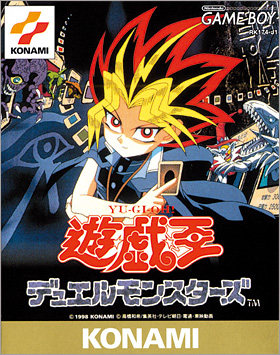 | |
| Kanji | |
| Romaji | Yugiō Dyuerumonsutāzu |
| Developer(s) | Konami |
| Publisher(s) | Konami |
| Series | Yu-Gi-Oh! Duel Monsters |
| Platform(s) | Game Boy |
| Release date(s) |
|
| Genre(s) | Card game |
| Related Galleries | Card gallery |
| Promotional Cards | Yu-Gi-Oh! Duel Monsters promotional cards |
Yu-Gi-Oh! Duel Monsters is the second Yu-Gi-Oh! video game, following Yu-Gi-Oh! Monster Capsule: Breed and Battle. It is the first game in the Duel Monsters series and the only game released for the Game Boy. It was published in Japan by Konami on December 16, 1998.[1]
Contents
Duels
The player must defeat each character in a stage five times to advance to the next stage. A character that has been defeated five times can be Dueled additional times for more cards. Here are the list of characters that a player may duel against:
| Opponents | Stage image | Opponent image |
|---|---|---|
| Stage 1 | ||
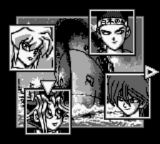
|
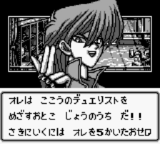
| |
| Stage 2 | ||
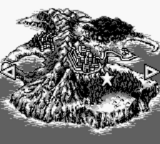
|
Seto Kaiba | |
| Stage 3 | ||
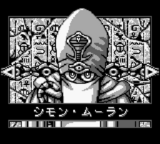
|
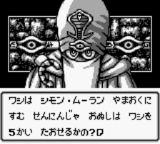
| |
| Stage 4 | ||
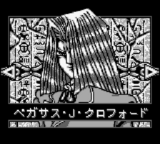
|
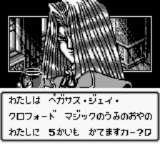
| |
| Stage 5 | ||
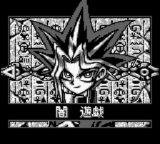
|
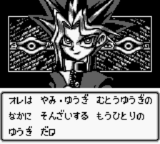
| |
Obtaining cards
Starter Deck
The player starts the game with a 40-card Starter Deck which includes 33 Monster Cards, selected randomly from a pool of 100 monsters, as well as seven Magic Cards, which are always the same.[2]
Opponent drops
When an opponent is defeated, the played is given a card.
Each opponent has a different list of cards the player can get for beating them, with each card on the list having an assigned probability of obtaining randomly it. See Joey Wheeler (Duel Monsters 1)#Random drops for example.
Each opponent also has a list of cards the player is guaranteed to obtain after defeating a number of times in multiples of ten, up to 100. See Joey Wheeler (Duel Monsters 1)#Milestone drops for example.
Link battle rewards
By taking part in a number of battles, using the Game Link Cable, the following cards can be obtained.
| # | Card | Number of battles |
|---|---|---|
| 015 | Flame Swordsman | 20 |
| 026 | Battle Ox | 30 |
| 329 | Dragon Capture Jar | 40 |
| 004 | Baby Dragon | 50 |
| 051 | Armored Lizard | 60 |
| 340 | Goblin's Secret Re | 70 |
| 316 | Electro-whip | 80 |
| 011 | Sword Arm of Drago | 90 |
| 349 | Spellbinding Circl | 100 |
| 016 | Time Wizard | 110 |
| 090 | Gyakutenno Megami | 120 |
| 066 | Kojikocy | 130 |
| 052 | Hercules Beetle | 140 |
| 346 | Ookazi | 150 |
| 317 | Cyber Shield | 160 |
| 079 | Megazowler | 170 |
| 073 | Kairyu-shin | 180 |
| 022 | Summoned Skull | 190 |
| 347 | Tremendous Fire | 200 |
Trading
Cards can be traded from other games using the Game Link Cable.
Yu-Gi-Oh! Duel Monsters can connect with other copies of Yu-Gi-Oh! Duel Monsters, as well as Yu-Gi-Oh! Duel Monsters II: Dark Duel Stories and the Japanese edition of Yu-Gi-Oh! Duel Monsters III: Dark Duel Stories.
Fusion Summon
The Extra Deck does not exist in this game. Fusion Summons can be performed in Duels by trying to Summon a monster from the hand on top of a monster on the field. Often the same monster can be Summoned, using various different Fusion Material.
By summoning a monster this way, the player only gets the monster for the duration of the Duel.
Link Cable Fusion
A Fusion can be performed using the Game Link Cable, while connecting to either a second copy of Yu-Gi-Oh! Duel Monsters or Yu-Gi-Oh! Duel Monsters III: Dark Duel Stories. This requires the two Fusion Material Monsters, as well as #289 "Change Slime".
The player gets to keep the card permanently, if they conduct a Fusion using this method.
| Fusion Monster | Material 1 | Material 2 | |||
|---|---|---|---|---|---|
| 037 | Gaia the Dragon Ch | 038 | Gaia The Fierce Kn | 039 | Curse of Dragon |
| 069 | Thousand Dragon | 004 | Baby Dragon | 016 | Time Wizard |
| 092 | Rabid Horseman | 026 | Battle Ox | 091 | Mystic Horseman |
| 056 | Larvae Moth | 123 | Dark Plant | 278 | Petit Moth |
| 157 | Firegrass | ||||
| 274 | Green Phantom King | ||||
| 273 | Ancient Tree of En | ||||
| 008 | Mushroom Man | ||||
| 075 | Man-eating Plant | ||||
| 158 | Man Eater | ||||
| 238 | Yashinoki | ||||
| 180 | Arlownay | ||||
| 072 | Cocoon of Evolutio | 123 | Dark Plant | 056 | Larvae Moth |
| 157 | Firegrass | ||||
| 274 | Green Phantom King | ||||
| 273 | Ancient Tree of En | ||||
| 008 | Mushroom Man | ||||
| 075 | Man-eating Plant | ||||
| 158 | Man Eater | ||||
| 238 | Yashinoki | ||||
| 180 | Arlownay | ||||
| 057 | Great Moth | 072 | Cocoon of Evolutio | 072 | Cocoon of Evolutio |
| 067 | Perfectly Ultimate | 057 | Great Moth | 072 | Cocoon of Evolutio |
| 217 | B. Skull Dragon | 022 | Summoned Skull | 082 | Red-eyes B. Dragon |
Passwords
Nine cards in Yu-Gi-Oh! Duel Monsters have passwords. These passwords use kana instead of numbers or letters, and each one is the name of a staff member who worked on the game, or who worked on the manga series at Shueisha at the time. This was probably done because Duel Monsters was released before the first OCG set, Vol.1, though it is not known why so few of the cards in Duel Monsters have passwords, especially since at least nine individuals are listed in the credits, but only six of them had passwords, and since Duel Monsters includes 15 secret monsters, but only nine of them can be unlocked with a password.
| # | Card | Password | Rōmaji | Notes |
|---|---|---|---|---|
| 351 | Yaranzo | ヘイシヨシヒサ | heishiyoshihisa | Heishi Yoshihisa was a long-time editor for Weekly Shōnen Jump. |
| 352 | Kanan the Swordmis | ハシモトカナコ | hashimotokanako | Kanako Hashimoto was the Director of Graphics for Duel Monsters. |
| 353 | Takriminos | チダタクリ | chidatakuri | Takuri Chida was a programmer for Duel Monsters. |
| 354 | Stuffed Animal | キタウエカズミ | kitauekazumi | Kazumi Kitaue was the Executive Producer for Duel Monsters. |
| 355 | Megasonic Eye | シモムラサトシ | shimomurasatoshi | Satoshi Shimomura was the Producer for Duel Monsters. |
| 358 | Seiyaryu | トリシマカズヒコ | torishimakazuhiko | Kazuhiko Torishima was the editor-in-chief for Weekly Shōnen Jump. |
| 359 | Three-legged Zombi | タカハシトシマサ | takahashitoshimasa | Takahashi Toshimasa was an editor for Weekly Shōnen Jump. |
| 361 | Flying Penguin | ヤマダノブヒロ | yamadanobuhiro | Yamada Nobuhiro was the Director of Game Design for Duel Monsters. |
| 363 | Fairy's Gift | タカハシカズキ | takahashikazuki | Kazuki Takahashi is the creator of Yu-Gi-Oh!, and was credited with Original Monster Design in Duel Monsters. |
Other
The following cards cannot be obtained by any of the above methods, apart from trading with another game.
- 204. Mabarrel
- 356. Super War-lion
- 357. Yamadron
- 360. Zera The Mant
- 362. Millennium Shield
- 364. Black Luster Soldi
- 365. Fiend's Mirror
Gameplay
Yu-Gi-Oh! Duel Monsters features 365 cards, with the last 15 cards being secret. The basic rules differ greatly from the OCG, and are generally simpler.
- There are 315 Normal Monsters (from number 001 to 300, and from 351 to 365) and 50 Spell Cards (from number 301 to 350) in the game; these are the only types of cards featured. None of the cards are Forbidden or Limited.
- While there are no Fusion Monsters (and thus no Fusion Deck), fusions can be performed by trying to summon a monster from the hand on top of a monster on the field (e.g. "Ansatsu" + "Darkfire Dragon" = "Flame Swordsman").
- Monsters only have an ATK, DEF, Type, and description. Levels, Attributes, and Alignments are not featured in Yu-Gi-Oh! Duel Monsters, and monsters can be summoned without tributing.
- There is no Deck Cost and no limit to the number of copies of one card which can be in a Deck, but the Deck must contain exactly 40 cards and the player can only have one Deck at a time. There is no Side Deck.
- Each Duelist's hand consists of five cards.
- Each turn has the same layout:
- The turn player draws a card.
- The turn player must play one card from their hand. If their hand is empty, the Duel ends and the Duelist with higher Life Points wins. Only one card can be played from the hand each turn.
- The turn player must attack with or switch to Defense Position each monster on their side of the field.
- The turn ends.
- The player always goes first in a Duel, but does not draw a card and cannot attack on the first turn.
- Attacking works the same as it does in the OCG and TCG.
- If the attack target is in Attack Position:
- If the monsters have different ATK, the monster with the lowest ATK is destroyed and its controller takes battle damage equal to the difference.
- If the monsters have equal ATK, both monsters are destroyed and neither Duelist takes battle damage.
- If the attack target is in Defense Position:
- If the attack target's DEF is greater than the attacker's ATK, neither monster is destroyed and the attacking monster's controller takes battle damage equal to the difference.
- If the attack target's DEF is lower than the attacker's ATK, the attack target is destroyed and its controller does not take battle damage.
- If the attack target's DEF equals the attacker's ATK, neither monster is destroyed and neither Duelist takes battle damage.
- If the opponent has no monsters, the turn player can attack the opponent directly. In this case, the opponent takes battle damage equal to the attacking monster's ATK.
- If the attack target is in Attack Position:
- The player receives a card after every win or draw. Milestone drops are also awarded after every 10 wins against each opponent, up to 100 wins per opponent.
Promotional cards
Each copy of Yu-Gi-Oh! Duel Monsters came with three cards randomly selected from the following set of ten cards:[1]
- "B. Skull Dragon"
- "Castle of Dark Illusions"
- "Dark Magician"
- "Hitotsu-Me Giant"
- "Mirror Force"
- "Monster Reborn"
- "Red-Eyes B. Dragon"
- "Ryu-Kishin"
- "Summoned Skull"
- "Swords of Revealing Light"
The cards in this promotional set were from Konami's Yu-Gi-Oh! Duel Monsters, a set of 21 cards that also included the Yu-Gi-Oh! Monster Capsule: Breed and Battle promotional cards and the Yu-Gi-Oh! Duel Monsters meeting experience card. All of these cards were printed as Holofoil Rares and are Illegal because they predate the OCG and use a completely different card design.
Game guides
Two game guides for Yu-Gi-Oh! Duel Monsters were published in Japan by Shueisha: Yu-Gi-Oh! Duel Monsters Perfect Master BOOK, published on December 21, 1998,[3][4] and Yu-Gi-Oh! Duel Monsters Perfect Master BOOK Volume 2, published in January 1999.[5] Neither guide included any bundled promotional cards.
Gallery
External links
References
- ↑ a b c http://www.konami.jp/products/yugioh_dm1_gb/
- ↑ http://datacrystal.romhacking.net/wiki/Yu-Gi-Oh!_Duel_Monsters:ROM_map#Starter_Deck_-_Random_card_pool
- ↑ 遊・戯・王 デュエルモンスターズパーフェクトマスターBOOK (in Japanese). Shueisha. December 21, 1998. Back cover. ISBN 4-08-779009-6. Unknown parameter
|trans_title=ignored (|trans-title=suggested) (help) - ↑ "遊☆戯☆王デュエルモンスターズパーフェクトマスターBOOK (上巻) (Vジャンプブックス―ゲームシリーズ) [単行本]" (in Japanese). Amazon.co.jp. Retrieved June 27, 2013. Unknown parameter
|trans_title=ignored (|trans-title=suggested) (help)CS1 maint: extra punctuation (link) - ↑ "遊☆戯☆王デュエルモンスターズパーフェクトマスターBOOK (下巻) (Vジャンプブックス―ゲームシリーズ) [単行本]" (in Japanese). Amazon.co.jp. Retrieved June 27, 2013. Unknown parameter
|trans_title=ignored (|trans-title=suggested) (help)CS1 maint: extra punctuation (link)
